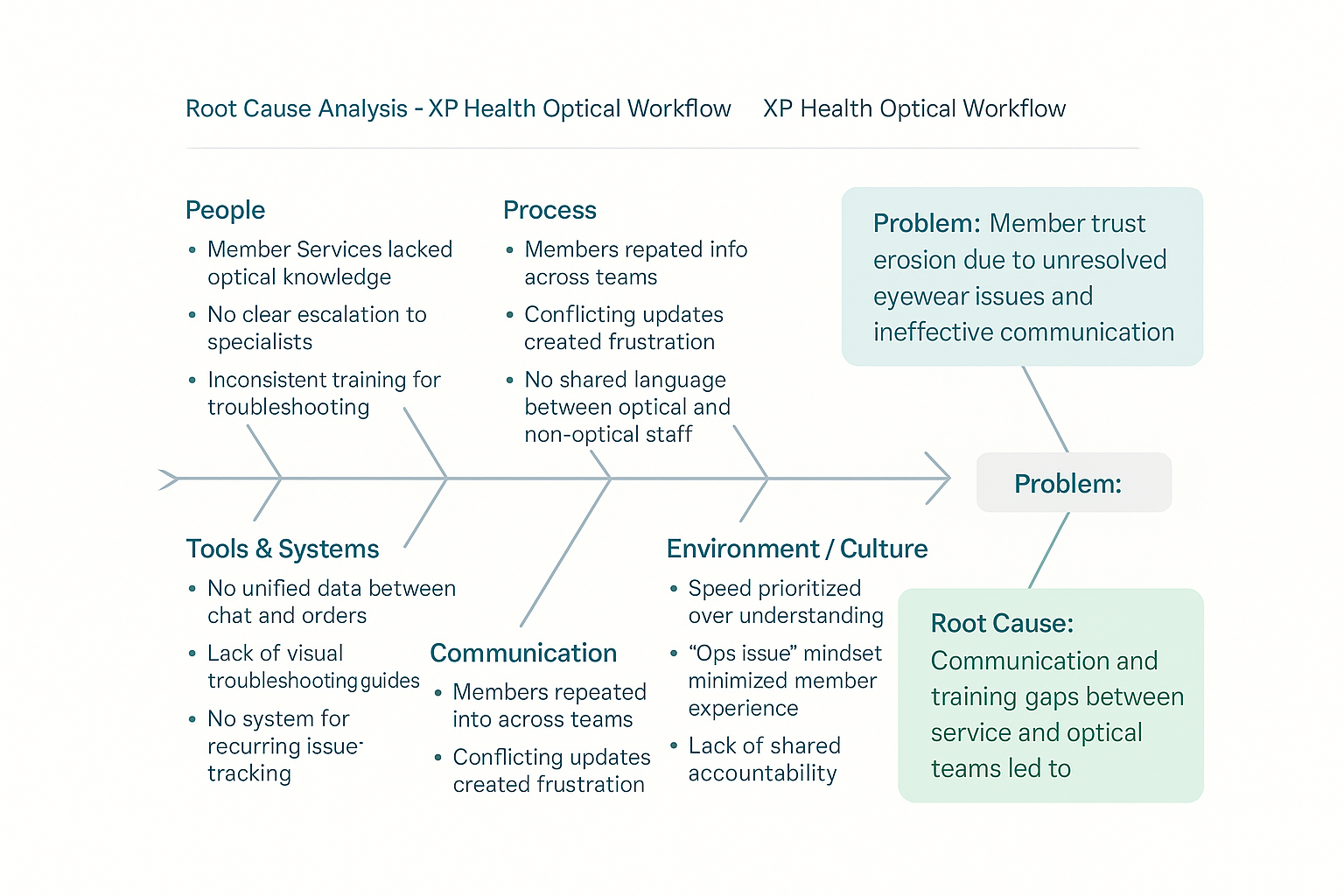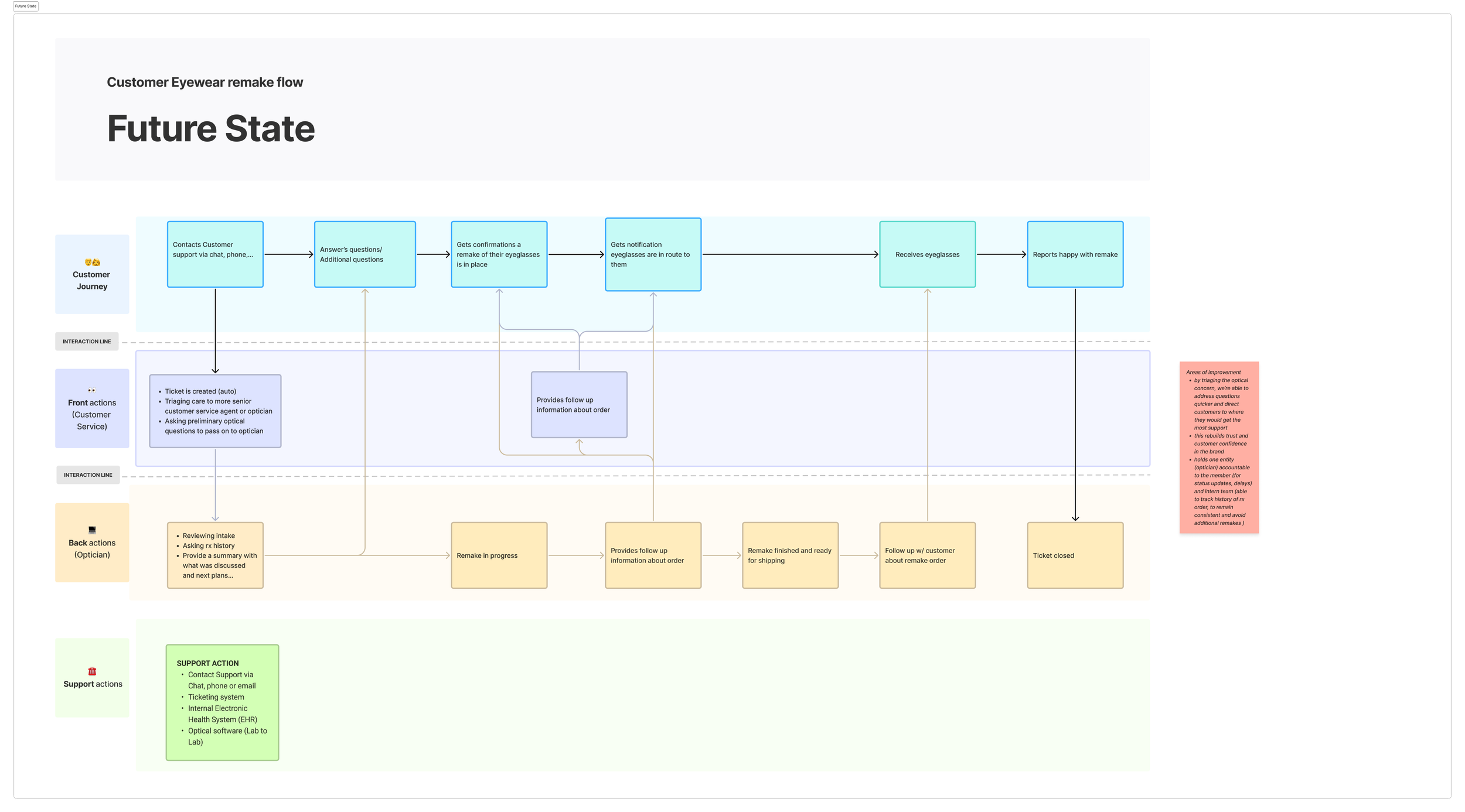Slowing down to solve faster: Rebuilding XP Health’s troubleshooting flow with care and clarity.
What happens when a health tech company is repeatedly remaking eyeglasses and nobody notices the pattern?
Led the redesign of the troubleshooting process from an optical and service design perspective.
Advocated for and implemented a new troubleshooting flow that included direct, face-to-face video calls with members.
Served as the escalation point and subject matter expert for complex eyewear issues.
Built repeatable communication practices and created clarity across internal teams.
Collaborated with the product team to implement additional visuals on the member-facing platform, improving clarity and user understanding.
My Role
The Problem
Eyeglass remakes were done without understanding the root issue, causing operational cost and poor user experience.
At XP Health, opticians on the operations team managed eyeglass remakes for members (members are the employees who are using their vision benefit through xp health) experiencing fit or vision concerns. I noticed the process lacked ownership and any available team member could handle a case, making it hard to track prior changes or reasoning. As a result, some orders were remade multiple times, frustrating both members and the operations team.
The Solution
By introducing a systematic root-cause analysis approach, I helped teams focus on identifying why problems occurred rather than simply reacting to them. This built cross-team trust, reduced duplicate remakes, and created a shared sense of accountability for resolution.
Create a process for member service to troubleshoot questions effectively.
Introduce live video consultations to address complex issues with clinical expertise.
Build out the optical team and remake process.
The Impact
Reduced second remake occurrences by up to 75% by streamlining eyewear resolution process. Ensuring first time orders and remake orders were accurate and aligned with patient expectations, minimizing delays and cost.
Achieved 25% reduction in avoidable ordering issues by improving the intake UX/UI. Clarified key decision points (e.g. type of lens) to improve accuracy and reduce confusion.
Rebuilt trust by establishing a clear point of accountability (the optician) by providing personalized communication, including a recap of the conversation (between member and optician). This approach gave members reassurance, clear expectations and a tangible resolution.
Designing for What’s Hidden
When I joined XP Health, I noticed that customer support staff had limited technical training to assess eyewear issues directly and had to rely on operations for a solution. This process would often take operations up to an average of 2 hours to respond, often resulting in either additional clarification or an incomplete answer. If a secondary remake was required, it could be handled by a different person leading to inefficiencies.
The red box highlights the main issue: Members would report problems → Customer Service (non-clinical) would relay information Operations→ Operations would remake blindly, often multiple times.
One case stretched over six months without a single point of accountability.
This resulted in:
Multiple unnecessary remakes
Erosion of patient trust
Increased operational costs
A frustrating overall experience
My Observations & Insights
The real issue wasn’t just technical, it was communication failure and limited optical insight overall.
Member Services needed deeper optical knowledge to confidently ask the right follow up questions.
Communication was via phone and chat threads but didn’t have the optical support and resolution to restore confidence.
I reframed the problem not as an internal ops issue but as a trust-breaking experience for the member. The key wasn’t remaking glasses faster. It was making space to understand the member’s problem more deeply.
My Solution
I proposed video calls as a way to talk in real time, build trust, and reduce miscommunication.
Members could explain their issue, I could ask follow-ups, and we could align on next steps together.
By communicating directly with the member, I was able to accurately document their chief concern, triage the issue and make notes as to why these changes will be made for their remake.
When I presented this to leadership, I focused on framing the issue through the member’s experience first:
highlighting the frustration caused by not having a clear point of contact.
I backed it up with optical evidence and case examples to show how having a trained professional guiding the process could reduce remakes and confusion.
I positioned the recommendation as both a service and operational improvement: giving members a real person who can interpret their concerns using optical expertise while creating accountability and consistency for the team.
Management supported the shift immediately and gave me full range to do what I needed to rebuild trust.
How it worked
When I was handed a ticket (member issue), I introduced myself (establishing credibility with certification) and asked additional follow up questions. I gave the member two options on communicating back: either a) via email as we were currently doing (written communication) or b) get on a video call (visual communication)
Video chat was not a form of preferred method before I came onboard however I felt that it would humanize the experience and make the member feel heard.
I conducted interviews by listening to their cheif concern and targeting these key areas of focus:
Prescription complexity
Changes in frame style
Lens material and design
Prior Rx and frame style history
I sent a follow up email with a recap of what was discussed to close with clarity, provided members with actionable next steps for remake, and the estimated time of the remake.
The Results
Reduced number of repeated remakes per member.
Created a new communication standard for complex troubleshooting cases.
Set the foundation for the VIP Consultation service, expanding from troubleshooting to proactive styling and Rx education.
Restored member trust and satisfaction, especially for frustrated or confused members(maintained a CSAT score of >95%)
Found a point upstream in the member’s eyewear ordering journey to increase clarification on what products they were purchasing.
Future State Vs. Current state: Ownership and Accountability
Reflection
Experience Design isn't always about the interface! Sometimes, it’s the invisible flow of people, roles, and conversation.
My years as an optician trained me to see patterns, relationships, and human needs in ways that now shape how I design.
Optical taught me to look beyond symptoms to the root of a problem, to blend empathy with evidence. That mindset is what drives how I approach service design today.
Strategic service design means slowing down enough to listen even to what’s not being said





